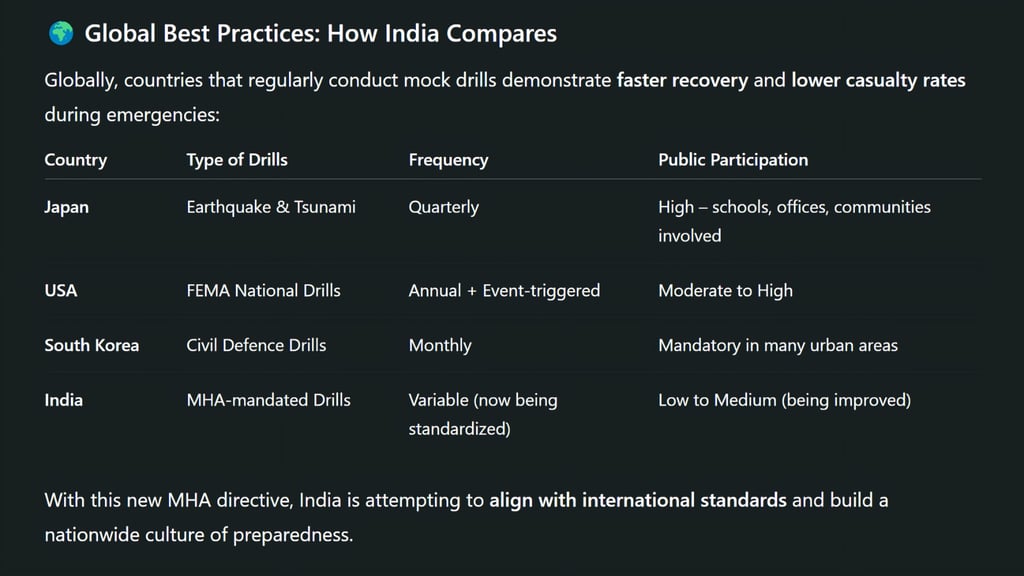
MHA Directs States to Conduct Mock Drills for Civil Defence Preparedness
India’s Ministry of Home Affairs (MHA) has urged all states and Union Territories to conduct mock drills to evaluate civil defence preparedness. This strategic move aims to strengthen emergency response, reduce disaster risks, and promote a culture of proactive resilience across the nation.
NEWS/CURRENT AFFAIRSA LEARNINGINDIA-PAKISTANINDIA/BHARATAWARE/VIGILANT
Keshav Jha
5/8/20253 min read


In an increasingly unpredictable world, disaster readiness is not a luxury—it’s a necessity. Recognizing this, India’s Ministry of Home Affairs (MHA) has formally directed all states and Union Territories to conduct comprehensive mock drills aimed at evaluating civil defence preparedness across multiple levels of governance. This move reinforces the central government's priority to ensure all citizens and institutions are equipped to face emergencies with confidence, coordination, and clarity.
Background: Why Civil Defence Is a National Priority Now
India ranks among the top disaster-prone countries globally, with over 27 of its 36 states and Union Territories vulnerable to one or more types of disasters. According to the National Disaster Management Authority (NDMA), over 58% of India’s landmass is earthquake-prone, 12% is flood-prone, and nearly 5,700 km of coastline is exposed to cyclones and tsunamis.
Additionally, man-made hazards—such as industrial accidents, chemical spills, and terrorist attacks—are evolving rapidly in urbanized zones. The MHA’s directive, issued through the Directorate General of Civil Defence (DGCD), seeks to proactively train authorities and citizens before disaster strikes.
What the Official MHA Directive Entails
The Ministry’s detailed advisory includes:
Monthly or Quarterly Mock Drills tailored to local hazard profiles.
Integration with Disaster Management Authorities (SDMAs and DDMAs).
Realistic Simulation Scenarios including floods, earthquakes, fires, pandemics, chemical spills, and bioterrorism.
Use of Emerging Tech: Leveraging GIS, drones, AI tools, and mobile alert systems during simulations.
Special Focus on Urban Clusters and industrial hubs, where the impact radius and risk are significantly higher.
Documentation & Analysis: Each drill must be followed by a full-fledged performance evaluation, submitted within 15 days to MHA's central command.
The Role of Civil Defence: Unsung but Indispensable
Civil Defence in India traces its roots back to World War II, primarily focused on protecting civilian populations during air raids. However, in today's context, it plays a far broader role:
First-response assistance during disasters.
Support to local administration during evacuations and relief operations.
Public safety training, especially in vulnerable regions.
Volunteer mobilization in medical aid, traffic control, and community alerts.
There are currently over 5 lakh registered Civil Defence volunteers in India, but the number active and trained remains considerably lower. These drills aim to revive and reinvigorate this dormant potential.


Areas of Focus in Mock Drills
To ensure holistic evaluation, the MHA has recommended mock drills across the following verticals:
Transport Hubs: Simulations in airports, metro stations, and railway terminals.
Educational Institutions: Evacuation drills in schools and colleges.
Healthcare Systems: Response to pandemics, biohazards, and hospital overloads.
Industrial Safety: Fire, chemical spill, or blast scenarios in factories.
Urban Floods & Earthquakes: Simulating rapid response in high-density zones.
Each drill is to be graded on response time, inter-agency coordination, resource mobilization, communication effectiveness, and public compliance.
Innovation & Tech in Drills
The government has encouraged the use of technology to modernize drill execution:
AI-powered simulations to predict casualty zones and response strategies.
GIS mapping for pinpointing vulnerable areas.
Drones to deliver aid or conduct real-time surveillance.
Mobile alert systems and emergency apps to notify and direct the public.
India’s C-DAC (Centre for Development of Advanced Computing) and ISRO have also been roped in to assist in developing disaster models and communication tools.
Community Involvement: The Core of Readiness
The MHA is encouraging Resident Welfare Associations (RWAs), Panchayati Raj Institutions, religious bodies, and NGOs to take an active part in organizing and participating in drills. This move ensures that preparedness isn’t limited to officials—it’s a collective responsibility.
The Ministry is also exploring public-private partnerships (PPPs) to ensure corporate entities, especially in the manufacturing and tech sectors, build in-house response protocols.
Expected Benefits from Regular Mock Drills
Faster disaster response with trained personnel and clear communication chains.
Lower casualties through early evacuation and efficient aid delivery.
Reduced property loss with quick containment of fires or chemical leaks.
Increased citizen trust in governance and safety measures.
Enhanced global image of India as a disaster-ready economy.
The Ministry of Home Affairs’ decision to standardize and enforce mock drills for civil defence preparedness is more than a bureaucratic exercise—it's a life-saving initiative. In a country as vast and diverse as India, readiness is power. These mock drills aren’t just about sirens and simulations—they’re about building a culture of prevention, participation, and protection.
With technology, training, and teamwork, India is not just preparing for disasters—it's preparing to overcome them with resilience and resolve.
Subscribe to our newsletter
All © Copyright reserved by Accessible-Learning
| Terms & Conditions
Knowledge is power. Learn with Us. 📚


